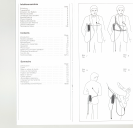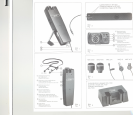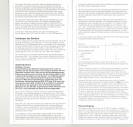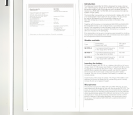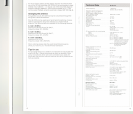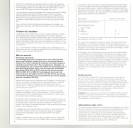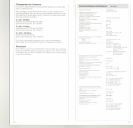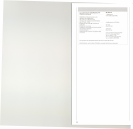
I,
The two microphones are easily mterchangeable. They are simply
plugged into the socket on the transmitter and screwed in. The
microphones are powered lrom the transmitter battery. Together
with the SK
1010they lorm one unit wh ich can be used as a hand-
held microphone or may be worn around the neck as a Lavalier
microphone. To avoid possible breath and wind noises it is
advisable to use the included windshield MZW 4012 A when using
the transmitter as a hand held microphone.
The especially Ilat constructlon 01the transmitter allows it to be used
as a pocket transmitter. For this application the Lavalier clip-on
mlcrophone MKE 10, MKE 40 Rand MKE 2 R have been devel-
oped. The MKE 10 and MKE 2 R have an omnldirectional character-
istic and the MKE 40 R cardioid characterislic. Both microphones
are powered by the transmitter.
Dynamic microphones may be connected via the connecting cable
DA
1012 N or DA 1012 U to the SK 1010.
Carry out a voice test! Position the microphone as itwill be used
later on. The test noise is a long-drawn-out "ueueue". Switch CD
should be set to "Test" and the sensitivity control 0 should now be
turned clockwise lrom position 1 - on the 1 to 7 scale - until the red
LED @only Ilashes on and off at the volume peaks. In this position
you still have a large modulation range, such that even sounds
which are appreciably louder are transmitted without distortion.
Good results will be achieved with the sensitivity control set to the
lollowing positions:
Microphone
MKE10/MKE40 R/MKE2 R
Position
Wearing the transmitter
When being worn as a Lavalier-microphone the transmitter is kept
away Irom the clothes by a small carrying device, in order to avoid
picking up Iriction noises. To lasten around the neck, the carrying
device CD(Iig. 2) is lixed to the transmitter by inserting the locking
inserts @01the carrying device mto the side opening @01the
transmitter housing and the device turned upwards. The cord 01the
carrYlng devlce is hooked into opening @on the holder.
For operation wlth clip-on microphones the transmitter is to be worn
as shown inlig. 7- 9.Another way 01wearing the SK1010 isthe use
01the holder SZK 1012 (Iig. 10).
MKE2010/MKE4010
1. hand-held
1.1near
1.2lar
2. around the neck
1
2
2-3
Operation
Important information:
The wiring arrangement of the input socket was chosen in such
a way that the transmitter may be remote-controlled from an
external switch. Therefore, the operating voltage lead was
interrupted and led across socket contacts 6 and 7. The trans-
mitter may be accordingly only opera ted when this interruption
is rejoined via a wire bridge in the microphones. MKE 2010 and
4010, as weil as clip-on microphones MKE 10, MKE 40 Rand
MKE 2 R contain this bridge. The connecting cables DA 1012 N
and DA 1012 U, suitable for connecting dynamic microphones,
also contain this bridge.
Belore operating the transmitter one should check to ensure that
transmitter and receiver Irequencles coincide. The Identilication
sticker CDIn the battery compartment contains the transmission
Irequency designation and the licence number, which are required
when applying lor a Ilcence to operate your transmitter.
For the lollowing please observe lig. 4: beside the microphone and
microphone socket respectively you will lind a small operatmg
panel wlth the sWltch CD,two LEDs @and @and the sensitivity
control 0.
In the position "Off" the unit is completely inoperative. II the opera-
tion switch ISput into position "Test", Ilrst the green LED @wililight
up il the battery voltage IS more than 6 V. Proper operation can be
expected il this control diode lights up brightly. IIthis diode glows
only dimly the battery should be changed or the accumulator
charged.
Control 0 enables the sensitivity 01the transmitter to be changed.
Since the proper lunctionmg 01the system is extremely dependent
on this control being set properly please read the lollowing section
carelully.
10
Please remember that whenever the transmitter is hand-held the
windscreen MZW 4012 A included in the screw-in microphones
packaging should be used.
II overmodulation still occurs when the rated swing is reached the
controlled amplilier will switch on. This enables a distortion-Iree
transmission even when the modulation range is grossly exceeded.
This mode does, however, have the slight drawback that
"breathing" noises (typlcal lor every controlled amplilier) must be
expected.
In cases where the transmitter is being used together with a hall PA-
system please ensure that the sensitivity control 0 is not used to
adjust the volume. The volume adjustment should be exclusively
carried out on the PA-system's amplilier and should be so adjusted
that there is an ample range available belore the leedback level is
reached. II noticeable distortion occurs when the transmitter is cor-
rectly adjusted then the problem is in the overloading 01the input
stage 01the PA-amplilier, caused by the relatively high output signal
(1.5V) 01the receiver. IIthis is the case it is recommended that a
suitable attenuated signal should be taken lrom the receiver output.
Piease check with the operating manual 01your receiver.
Phono input
The SK 1010-6 and SK 1010-7 are equipped with a 2.5 mm !/Jjack
socket which enables the connection 01tape recorders etc. The
input sensitivity is 120 mV at 57 kil. Higher signal levels may be
applied as they are reduced bya limiter amplilier, but it should be
avoided whenever possible. II the signal level is much higher than
120 mV, we recommend the insertion 01an external potentiometer
into the signalline as the sensitivity control 01the transmitter is
inoperative lor this input.
Hint: The microphone module used must remain plugged in as it
contains a wire bridge between pin 6 and 7. Without the wire bridge
the transmitter can't be put into operation. IIyou want to do without
microphone an external wire bridge has to be connected.
Battery / Accumulator operation
IIyou are using the more powerful100 mW resp. 50 mW transmitter
please note that the transmitter will only operate properly with alkali-
manganese batteries. This type 01battery is slightly more expensive
than the equivalent zinc-carbon battery, but they can supply power
11
--




